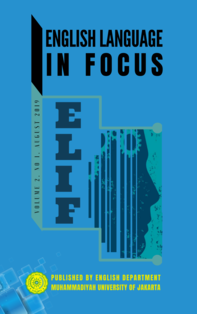The Effect of Scaffolding toward Students’ Writing Procedure Text
DOI:
https://doi.org/10.24853/elif.2.1.33-42Keywords:
scaffolding technique, writing, procedure textAbstract
The purpose of this study was to determine whether scaffolding can have a significant effect on students' ability to write procedure texts. In this study, the sample used is the students of grade XI SMA Muhammadiyah 25 Setiabudi Pamulang. The sample was from the class XI IPA 1 as the experimental class and XI IPA 2 as the control class. Each of them consists of 36 students. The writer used purposive sampling technique in determining the number of samples from the existing population. The method used was quantitative and the design used was quasi-experimental study. The instrument in this study was a written test. To ensure the reliability of the instrument, the writer uses a rubric in the assessment called analytic scoring adopted from John Anderson to assess student writing in pre-test and post-test. The findings of this study were the mean score of pre-test of experimental class students was 56.47 and the mean score of the student's post-test was 76.14. In contrast, the students’ pre-test mean score of the controlled class was 63.25 and the mean score for the post-test was 66.72. The significant effect was shown by the students’ post-test mean score of the experimental class which was treated by scaffolding technique was greater than the post-test mean score of the controlled which was not treated by scaffolding technique. The result of the statistical hypothesis test found that on significance level 0.000 < 0.005. Thus the H0 (Null Hypothesis) was rejected and the H1 (Alternative Hypothesis) was accepted. It proved that the application of scaffolding technique is effective towards the students’ skill in writing procedure text.References
Anderson, M., & Anderson, K. (2003). Text Types in English 3. South Yarra: Macmillan Education Ltd.
Brown, H. D. (2012). Principles of language learning and teaching. Britain: Longman.
Celce-Murcia, M., Brinton, D., & Snow, M. A. (2014). Teaching English as a Second or Foreign Language. New York: Heinle Cengage Learning.
Hammond, J. (Ed.). (2001). Scaffolding: Teaching and Learning in Language and Literacy. Australia: Primary English Teaching Association.
Lindsay, C., & Knight, P. (2006). Learning and Teaching English. New York: Oxford University Press.
Mertens, D. M., & McLaughlin, J. A. (2004). Research and Evaluation Methods in Special Education. California: Corwin Press.
Muijs, D. (2004). Doing Quantitative Research in Education with SPSS. London: Sage Publication.
Raymond, E. B. (2012). Learners with Mild Disabilities: A Characteristics Approach. Needham Heights, MA: Pearson.
Read, S. (2010). A Model for Scaffolding Writing Instruction: IMSCI. The Reading Teacher, 64(1), 47–52. Retrieved from https://digitalcommons.usu.edu
Spratt, M., Pulvernes, A., & Williams, M. (2005). The TKT Course. Cambridge: Cambridge University Press.
Downloads
Published
Issue
Section
License
Authors who publish with this journal agree to the following terms:
- Authors retain copyright and grant the journal right of first publication with the work simultaneously licensed under a Creative Commons Attribution License that allows others to share the work with an acknowledgment of the work's authorship and initial publication in this journal.
- Authors can enter into separate, additional contractual arrangements for the non-exclusive distribution of the journal's published version of the work (e.g., post it to an institutional repository or publish it in a book), with an acknowledgment of its initial publication in this journal.
- Authors are permitted and encouraged to post their work online (e.g., in institutional repositories or on their website) before and during the submission process, as it can lead to productive exchanges, as well as earlier and greater citation of published work (See The Effect of Open Access).


